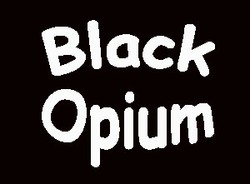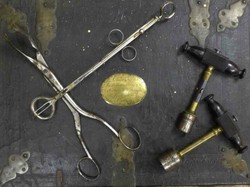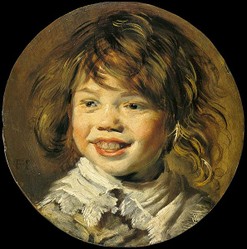Not all artwork is equal. I am not one much for elitism or for snubbing my way around the "High Art" exclusionary circuit. However it is quite clear that some artworks raise consciousness and other artwork is at least a reflection of some aspect of society. Only very select works have the potential to make people think, see afresh and question mores that had hitherto 'just been accepted' by society.
The processes of disremembering can be quite evil. The kinds of repressive psychological processes that Foley and Harrington address can cause a high degree of cognitive dissonance. Let's look at the way that Fiona Foley sought to blaze a trail through dissonance to facilitate real dialogue.

What Does Fiona Foley's Work Mean to Australia?
by Jo_Murphy
An artist's work has at least two impacts the first is that it raises consciousness within the country. The second is that it raises the countries art profile Internationally.
The Methodology of Fiona Foley
Gentle, Caring, Understanding but Firm
Fiona Foley (born 1964) is a contemporary Indigenous Australian artist from Badtjala, Fraser Island, Queensland.
Foley uses her art to "explore the tensions between sex, race and history and their various constructions". (Wikipedia) By referring to her own unique life history as an "indigenous woman growing up in regional Queensland, in a community with a living memory of their colonisation by the English", Foley sets the scene for a robust dialogue that has the potential to bring about healthy debate throughout Australia.
Nothing could be more important to Australia now than an honest hard, long look at the way Australia was colonized. As we discuss and debate about the recent increase in attempts by 'boat people' to come to Australia, and the way the media has beefed up this 'supposed' invasion, we as a people must look closely at how we justify our stand against them. Both sides of the debate about these people's right to set foot on our shores has fueled the aggression with hysteria, and with an attempt at systematic disremembering. Distortion is further twisted by the choice of the 'lens' through which we are prepared to look at the problem. Australia cannot simply "get rid" of the 'problem' these people represent by shipping them off somewhere else or turning them back.
What I want to discuss in this article is the concept of Cognitive Dissonance. It is with this intention in mind that I discuss the ingenuity of Foley's work. I am not discussing the content of the work, I am looking specifically at the methodology. What Foley has done is invent a way of speaking to the Australian population that is balanced, just and fair.
To keep the discussion simple and contained I have chosen to look at the way she set up the installation project called "Black Opium".
Black Opium
An installation "Of the people, for the people, by the people".
To provide a backdrop for this discussion I would like you to take a look at the article written by Jo Harrington, called Visiting Auschwitz 20 Years after Writing my Dissertation. This is an extremely interesting post because she draws our attention to how hard it is for us to look at this information. One of the aspects of the pilgrimage she describes is the way she felt rushed and unable to cope with the influx of information. She was on a guided tour that operated to schedule.
I contrast this to the way that Black Opium has been constructed. Black Opium is a beautiful installation. One of the surprising things about it is that unless you are told about it, or have read the literature, you do not automatically look up to see it. You could, interestingly enough, walk straight past the installation! I had done this many times without consciously seeking to find out what it was. I had also noticed the booths that are set out near the installation, but I didn't actually go in and sit down.
Based on that aspect of the installation alone, you could not get away with calling Fiona Foley pushy. Her work is tasteful, balanced well thought out and definitely not 'in your face'. What the artist has done, is to very cleverly place the installation above the head of the audience so that they need to actively work to see it. This means that the audience must fully participate with the installation if they are to decode the intention of the silver sculpted infinity sign.
A Glimpse at the Processes of Cognitive Dissonance
Facing the Past in Order to Recover
The yolk of imprisonment that caused the blight on Australian history called "The Stolen Generation."
A mechanism of supression
You may ask, "How can a multimedia installation convey the horror and sorrow connected with a time in Australia's past when Aboriginal people were often paid for their labors in opium?"
The answer is that Foley knew how hard it would be for White Australians to look at this information. She not only created a clever and beautiful ceiling installation but placed it next to meditation booths, so that instead of rushing through an exhibition reeling in shock, viewers are able to focus in a composed manner. At the same time they can glean an understanding of the impact conspiring to induce sensitive people into addicition could bring. The booths have different themes, which help this process. While trying to understand the information people can sit in booths to look at photographs and artifacts, where they can also read and meditate.
It is interesting that Foley was able to design a beautiful instrument to enable the raising of consciousness that has been able to lift the veil of disremembering. We can now openly discuss a process that was intentionally used to rob Indigenous people of their health and very often their lives.
Black Opium Installation
777 silver opium poppies
The Black Opium Installation is an intriguing formation of 777 silver opium poppies arranged in the shape of a sideways figure eight. In her usual clever manner, Foley has used a universal symbol to signify the suffering of Indigenous people; the symbol of infinity.
Because the State Library of Queensland is the home of the John Oxley Library, exhibition goers have immediate access to authentic historical documents about this period of Queensland's history. Readers can sift through information and old documents for themselves, confirming the unpleasant realities about Queensland's recent past. This is a syntegrative installation woven from video, photographic material, text and other educational material.
It is exquisitely put together in a way that does not confront, harm, shame or blame people who can take from the work as much as they are capable of on any given day.
By working this way it is more likely that viewers will return time and again as they learn to 'see' the past and present realities more honestly.
What Makes Great Art
Great Breakthroughs in the Art World Don't Happen Every Day
 | Art Rules: Pierre Bourdieu and the Visual Arts Pierre Bourdieu is now recognized as one of the key contemporary critics of culture and the visual arts. Art Rules analyses Bourdieu's work on the visual arts to provide the fir... |
Great Art "Breaks Through Into Consciousness".
Cognitive Dissonance Will Always Be With Us
Cognitive dissonance is a term used to describe the way people fight back when they experience feelings of psychological discomfort. Quite a deal of pain can accompany facing 'truths' that conflict with an already held belief. Sometimes these beliefs are very precious. They revolve around an idea that rings out "We are great- and - They are not!" This is the precious idea behind racism, and the people who hold this kind of belief don't feel they have to defend their stance.
Because the REALLY believe it.
Never under estimate the power of cognitive dissonance. By dealing with the possible effects of her installation, Foley has been able to make real break throughs in the way people view relations between Indigenous and White Australia. Let's hope that this deepened understanding seeps into other areas of Australian politics, so that rather than look back with shame and regret, we curb our exclusionary and repressive behaviours before others are hurt by them.
You might also like
Gangsters and Gunslingers: The Good, the Bad & the Memorabilia...Gangsters & Gunslingers: The Good, the Bad & the Memorabilia, explores two ke...
The Happy Museum Project - Reaching Out to the CommunityMany museums are now extremely accessible to people from all walks of life, i...






 As We Age - We React to Life's Challenges Differentlyon 03/16/2024
As We Age - We React to Life's Challenges Differentlyon 03/16/2024
 Organic Gardening - Cunnamulla Styleon 03/08/2024
Organic Gardening - Cunnamulla Styleon 03/08/2024
 Cunnamulla - Premium Destination Outbackon 12/17/2023
Cunnamulla - Premium Destination Outbackon 12/17/2023
 OpenAI and Watermarkson 02/06/2024
OpenAI and Watermarkson 02/06/2024



Comments
Absolutely - that and much - much more!
Fingers crossed!
Might the festival be an opportunity for the interview that you mentioned in the comment boxes to your Ego Leonard wizzley?
I will need to do some research to be able to answer this. BTW. I wrote to Leon Kerr, and he replied. I am attempting to have him come to our festival. He just might!
Banksy perhaps can be considered an evolution from pop to high art. So perhaps can Ego Leonard now that I know of his versatility as Leon Keer.
It's somewhat a mystery as to who decides since perhaps it's correct that, as Bob Dylan says, the executioner's face always is well-hidden.
Mightn't it be possible that decision-making faces are too?
But perhaps critics, family, fellow artists, passersby, specialists (such as art auctioners, art marketers, art purchasers) and teachers number among them.
Well. This is just an opinion. MY answer would be yes. Interestingly; this causes readers to ask the question "Who decides?"
Who do you think decides these things Derdriu?
Thank you!
The following arises because of just reading your recentest wizzley about Ego Leonard.
Might Banksy be considered an evolution, like Warhol, from pop into high art what with the prices and values of his art?
Might Ego Leonard be considered a possible such evolution?
I guess I think of High Art as cultured. It is probably produced by a deep thinker, and it has percolated over a long period of time. It is reflective. I don't really think of any art as 'low' though. POP is more a description of easily marketed, widely appealing art. It is usually transitory. Byt then by using his art the comment on popular art by Andy Warhol (at least in a sense) became high. He will stay the distance. He will be written about That is my mere opinion though. Jo
The second sentence in the introductory paragraph contains the phrase "high art."
Some online sources define it as forms and genres deemed companionable with classical music, poetry and sculpture." Others explain it as aesthetics-oriented artistry, as opposed to function- and utility-oriented low arts.
Is either one of those a correct, current definition?
Thanks Jo for the encouragement!
Jo M
I'm looking forward to the article. Just because I don't intuitively understand these things, it doesn't mean that I'm not fascinated by them!